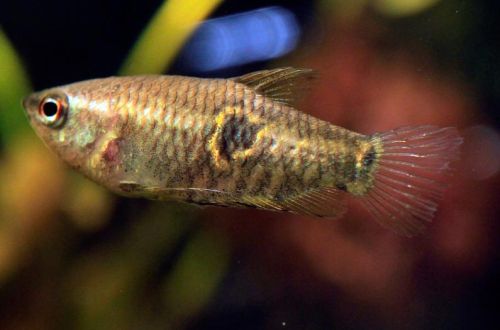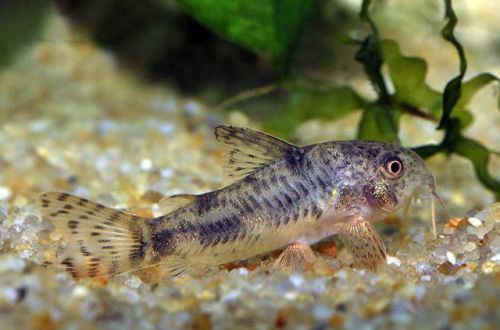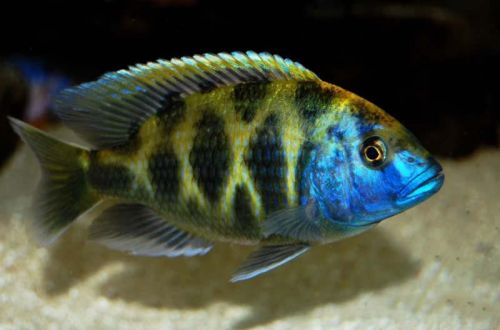
Gourami ocellatus
Gourami ocelatus or Ocellated Parasphericht, scientific name Parasphaerichthys ocellatus, belongs to the Osphronemidae family. Other popular names are Dwarf Chocolate Gourami or Burmese Chocolate Gourami. Easy to keep, compatible with other fish of similar size, may be recommended to aquarists with some experience.

Contents
Habitat
Comes from Southeast Asia. It inhabits the upper basin of the Ayeyarwaddy River in northern Myanmar (Burma), as well as with river systems associated with Lake Indojii Natural, the largest in the region. Inhabits small streams and rivers with a slow current, densely overgrown with dense aquatic vegetation. Spends most of the time hiding among the plants.
Brief information:
- The volume of the aquarium – from 40 liters.
- Temperature – 15-25°C
- Value pH — 6.5–7.5
- Water hardness – 2–10 dGH
- Substrate type – any dark
- Lighting – subdued
- Brackish water – no
- Water movement – little or no
- The size of the fish is about 3 cm.
- Food – any food
- Temperament – peaceful
- Content – single, pair or in a group.
Description
It is considered a relative of the Chocolate Gourami and shares traits with it. For example, unlike other gourami, they do not have modified filamentous fins. Adult individuals reach a length of about 3 cm. The fish has a relatively large head in relation to the body and short fins. The color is gray-yellow, the main shade depends on the lighting. A characteristic feature is the presence in the middle of a large dark spot with a golden edging. Sexual dimorphism is weakly expressed. Sexually mature females look somewhat larger than males.
Food
Acclimatized fish, or those that have been living in artificial environments for generations, have successfully adapted to accept popular flake and pellet foods. You can diversify the diet with live or frozen foods, such as brine shrimp, daphnia, bloodworms and others.
Maintenance and care, arrangement of the aquarium
The optimal size of the aquarium for one or two fish starts from 40 liters. In the design, it is desirable to use a large number of aquatic plants and a soft substrate. Driftwood and leaf bedding will give a more natural look. Decorative items will serve as an additional place for shelters.
The dried leaves of some are intended not only for decoration, but also as a means of giving the water a composition similar to that in the natural habitat of Gourami ocelatus. In the process of decomposition, the leaves release tannins and turn the water brown. Read more in the article “Which tree leaves can be used in an aquarium.”
Successful long-term management depends on maintaining stable water conditions within an acceptable temperature and hydrochemical range. The desired stability is achieved by carrying out a series of obligatory aquarium maintenance procedures and installing the necessary equipment.
Behavior and Compatibility
A peaceful, timid fish that is unable to compete for food with larger, more active tankmates and may become malnourished in this situation. Recommended to be kept in a community with similarly peaceful calm species of comparable size. Intraspecific conflicts were not noted, they are able to live both singly and in a group. The latter option is preferable.
Breeding / breeding
Breeding in a home aquarium is possible, but involves a number of difficulties. The main difficulty lies in the preservation of the fry that have appeared. The most favorable conditions are achieved with separate keeping, when a pair of male and female are separated from other fish. With the onset of the breeding season, the male builds foam-air nests near the surface among floating plants. The fish acquire a “marriage” color – they become dark. Gourami ocelatus spawn for several days, adding eggs to the nest, and, if necessary, building a new one nearby. The male remains in close proximity to the clutch, guarding it. The female swims away. The incubation period lasts 3-5 days. For a few more days, the fry stay in the nest, feeding on the remains of their yolk sac, and only then begin to swim freely. Feed should be specialized feed intended for juvenile aquarium fish.
Fish diseases
The cause of most diseases is unsuitable conditions of detention. A stable habitat will be the key to successful keeping. In the event of symptoms of the disease, first of all, the quality of the water should be checked and, if deviations are found, measures should be taken to correct the situation. If symptoms persist or even worsen, medical treatment will be required. Read more about symptoms and treatments in the Aquarium Fish Diseases section.





